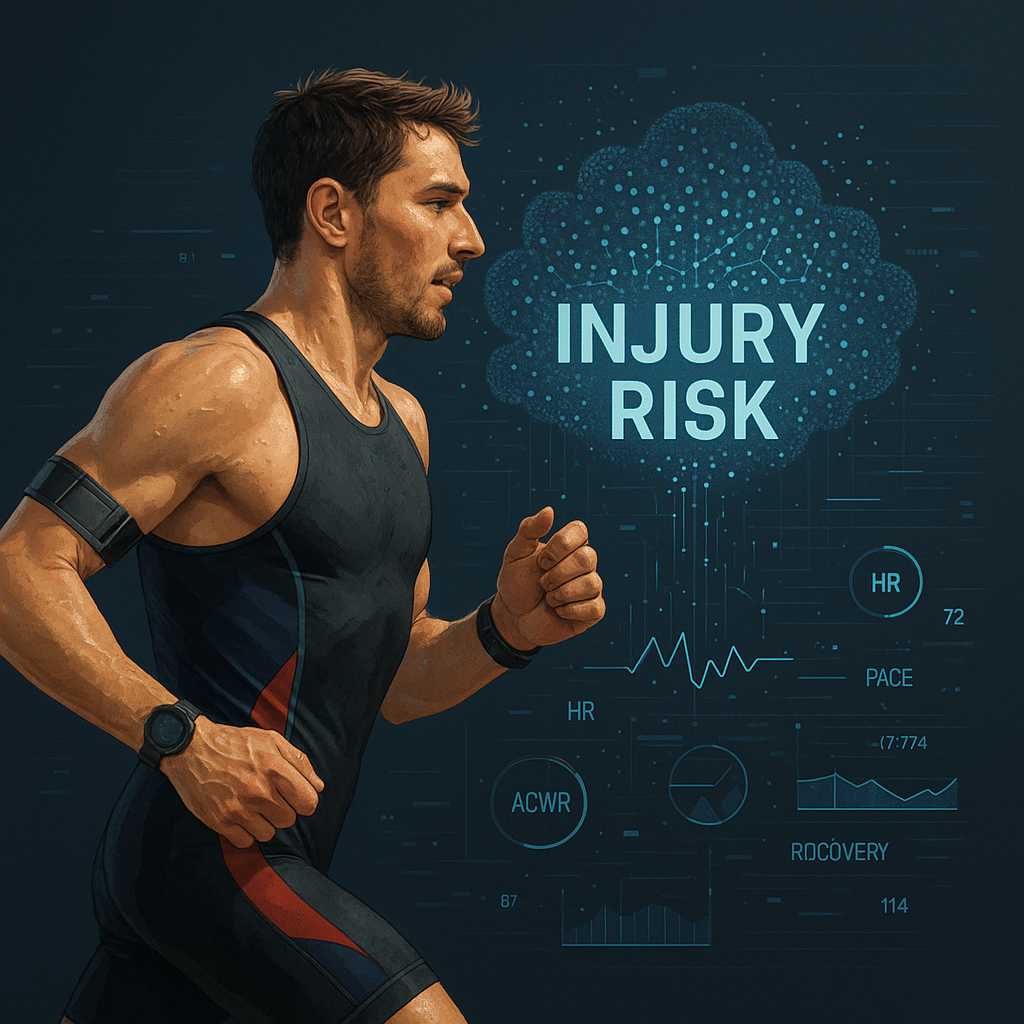Triathlon pushes the human body to its limits: swimming, cycling, and running in high volumes demand extraordinary resilience — and come with a serious risk of overuse injuries. Studies show that more than half of long-distance triathletes experience overuse problems within a season. Traditional training metrics like heart rate, pace, or power only scratch the surface. What’s missing is a holistic perspective. A new study on AI injury prediction in triathlon explores exactly this idea: by combining training load, recovery, sleep, and stress data with synthetic athletes and machine learning, researchers aim to predict injuries before they happen — and help triathletes train smarter, not just harder.

This article is based on the conference paper by Rossi & Rodrigues (2025) and reflects my own understanding of its findings. The summary is written in my own words and represents my interpretation, not an official reproduction of the original publication. While I strive for accuracy, please consult the original paper for full details.
Rossi, L., & Rodrigues, B. (2025). Beyond Training: A Personalized Holistic Injury Prediction in Triathletes. Proceedings of the IEEE International Conference on Smart Computing (SmartComp 2025). IEEE. https://doi.org/10.1109/SMARTCOMP.2025.1234567
Table of Contents
The Problem: When Training Outpaces Recovery
Overuse injuries arise when training loads exceed recovery capacity. While wearables provide continuous streams of data — HRV, sleep, stress, power, pace — interpreting these numbers in real-world training remains difficult. Most existing models focus on one sport or one metric. Triathlon’s unique multi-sport complexity is still largely ignored.
AI injury prediction in triathlon: Synthetic Athletes and Virtual Seasons
A core innovation of the Beyond Training framework is the creation of synthetic athletes — digital profiles that replicate the physiology, training history, and lifestyle patterns of real triathletes.
Each synthetic athlete is defined by 24 parameters, including VO₂max, heart rate thresholds, training history, sleep quality, diet, and stress levels. Based on these, an annual training plan is simulated using periodization principles (base, build, peak, recovery). Importantly, the model includes real-life deviations: fatigue after poor sleep, work stress, or pushing harder than prescribed.
This produces rich, daily time-series data for heart rate, pace, power, and recovery — the kind of multimodal dataset that real-world athletes rarely share due to privacy, but which is crucial for injury prediction in triathlon.
Modeling Injury Risk: The Formula
At the heart of the framework is a probabilistic injury model:
\(P(\text{injury}) = f(\text{ACWR},\; \text{fatigue},\; \text{recovery},\; \text{athlete factors})\)- ACWR = Acute:Chronic Workload Ratio (safe zone ≈ 0.8–1.35)
- Fatigue = accumulated training stress
- Recovery = sleep quality, HRV, resting HR
- Athlete factors = genetics, age, lifestyle
The model reflects the non-linear nature of injuries: if several factors align negatively, risk doesn’t just add up — it spikes.
AI in Action: Detecting Risk Before Symptoms
On top of this synthetic dataset, machine learning models (Random Forest, XGBoost, LASSO regression) are trained to spot hidden patterns of rising injury risk before athletes feel pain.
Unlike previous approaches, this model integrates training, lifestyle, and recovery data — making predictions more personal and actionable.
📦 Quick Example: When Small Things Add Up
Imagine this week looks like this:
- Monday: Hard intervals after just 5 hours of sleep.
- Tuesday: Long bike ride, but HRV is low from work stress.
- Wednesday: Swim session cut short, fatigue still high.
- Thursday: Another run, pace feels harder than usual.
- Friday: Rest day, but again only 6 hours of sleep.
👉 To you, it just feels like a “normal tough week.”
👉 To the model, it’s a red flag: high load (ACWR ↑) + poor recovery (sleep ↓, HRV ↓) + stress.
Result: Injury risk score spikes.
Action: Dial back the weekend long run → injury avoided.
What It Means for Triathletes
- Early warning system – Daily “injury risk scores” could soon sit next to your TSS chart.
- Smarter coaching – Proactive adjustments to training loads before problems appear.
- Privacy-preserving – Synthetic data allows big AI models without sharing personal health data.
Bottom Line
The Beyond Training project shows how injury prevention in triathlon can move from guesswork to data-driven foresight. By merging synthetic athlete data with AI, the vision is clear: a future where you don’t just train harder — you train smarter, stay healthier, and keep the consistency that performance demands.
Key Takeaways
- Over half of long-distance triathletes suffer overuse injuries.
- It’s not just training volume — sleep, stress, and recovery matter.
- Synthetic athletes + AI create a new way to predict risks.
- Risk spikes when multiple stressors hit at once.
- The future: a daily injury risk score that helps you avoid setbacks.
Precisely plan your next race with our race pace calculator!